
What is Structured Prediction?
Structured prediction is a fascinating concept that plays a crucial role in various fields, including natural language processing, computer vision, and machine learning. In simple terms, structured prediction refers to the process of making predictions or decisions where the output is organized in a structured form.
When dealing with structured prediction, the goal is not just to make a single prediction, but rather to predict a complex output that has some inherent structure. This could involve predicting sequences, graphs, trees, or other structured objects.
Structured prediction is different from standard machine learning tasks where the output is a single value or a binary decision. It introduces a new level of complexity by considering the interdependencies between different parts of the output and capturing the relationships within the structured data.
Key Takeaways:
- Structured prediction involves making predictions or decisions that have an inherent structure.
- It is applicable in various fields, including natural language processing, computer vision, and machine learning.
So, how does structured prediction work? Let’s take an example to understand it better. Imagine you want to build a machine learning model that can automatically generate captions for images. In this case, the output is not just a single sentence; it’s a sequence of words that forms a coherent and meaningful caption. The challenge here is that each word in the sequence is dependent on the previous words and, in some cases, even on the visual content of the image itself.
To tackle this problem, structured prediction algorithms use techniques like Conditional Random Fields (CRF), Hidden Markov Models (HMM), or Graphical Models. These models capture the dependencies between different parts of the output and leverage the relationships within the structured data to make more accurate predictions.
Key Takeaways:
- Structured prediction techniques rely on models like Conditional Random Fields (CRF), Hidden Markov Models (HMM), or Graphical Models.
- These models capture the dependencies and relationships within the structured data to make accurate predictions.
Structured prediction is a powerful concept that enables machines to understand and generate structured outputs, making it a fundamental building block in many AI applications. By incorporating the inherent structure of data into prediction tasks, structured prediction techniques provide advanced capabilities for solving complex problems in diverse domains.
So, the next time you come across the term “structured prediction,” you’ll have a better understanding of what it means and how it plays a crucial role in various fields.
